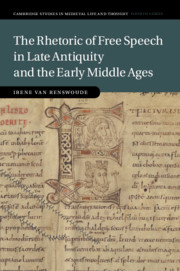Book contents
- The Rhetoric of Free Speech in Late Antiquity and the Early Middle Ages
- Cambridge Studies in Medieval Life and Thought Fourth Series
- The Rhetoric of Free Speech in Late Antiquity and the Early Middle Ages
- Copyright page
- Dedication
- Contents
- Acknowledgements
- Abbreviations
- Introduction
- Part I
- Part II
- 6 The Frank Holy Man
- 7 Gregory of Tours
- 8 The Wise Adviser
- 9 Agobard of Lyon
- 10 Pope Gregory
- Epilogue Part II
- Bibliography
- Index
Epilogue Part II
from Part II
Published online by Cambridge University Press: 23 September 2019
- The Rhetoric of Free Speech in Late Antiquity and the Early Middle Ages
- Cambridge Studies in Medieval Life and Thought Fourth Series
- The Rhetoric of Free Speech in Late Antiquity and the Early Middle Ages
- Copyright page
- Dedication
- Contents
- Acknowledgements
- Abbreviations
- Introduction
- Part I
- Part II
- 6 The Frank Holy Man
- 7 Gregory of Tours
- 8 The Wise Adviser
- 9 Agobard of Lyon
- 10 Pope Gregory
- Epilogue Part II
- Bibliography
- Index
Summary
On the north-east edge of Hyde Park in London, near Marble Arch and Oxford Street, is a designated site for public speeches and debates, known as Speaker’s Corner. Since the Act of Parliament of 1872, anyone who enters the Speaker’s Corner is allowed to speak freely on any topic he or she chooses, offence to the British royal family excepted. The institution of a free speech zone in a public place is not unique, since free speech zones can be found in many major cities across Europe and America. What is remarkable about Speaker’s Corner is its location: it was established on a previous site of execution. London tourist guides inform visitors that the Speaker’s Corner’s tradition of free speech took its beginning from the Tyburn gallows, which were located on this very spot. Prisoners who were sent to the Tyburn gallows were allowed to speak freely before they were executed.
- Type
- Chapter
- Information
- Publisher: Cambridge University PressPrint publication year: 2019

